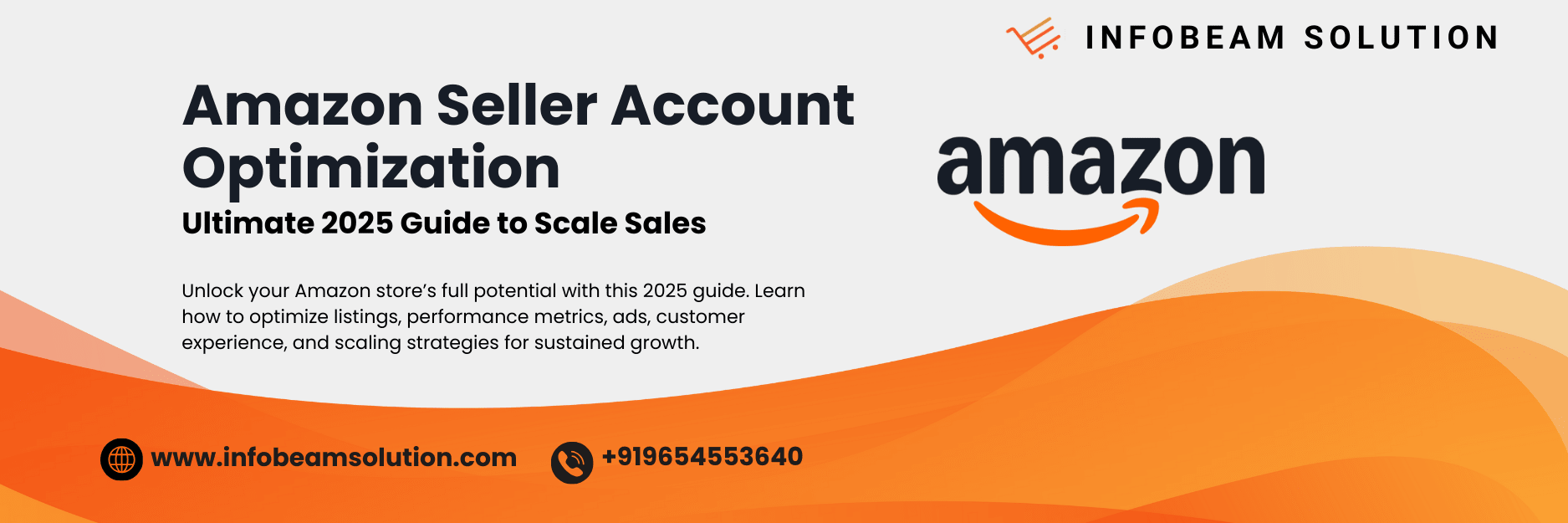Amazon Seller Account Optimization: The Ultimate 2025 Guide

Table of contents
Introduction
Your Amazon seller account is more than just a listing manager – it’s the command center for your brand’s success. Optimizing your seller account means fine-tuning every aspect (listing content, backend settings, fulfillment, advertising, performance metrics, customer experience) so everything aligns to boost sales, increase visibility, and maintain compliance.
In 2025, the competition is fiercer. Amazon’s algorithm, customer expectations, and marketplace dynamics continue to evolve. This guide gives you a step-by-step approach to optimize your seller account holistically for 2025 and beyond.
Why Seller Account Optimization Matters
Optimizing your account is not just about one listing-it ensures every component of your operation supports growth:
- Better search visibility across all your listings
- Higher conversion rates from cleaner listings, better images, compelling copy
- Improved seller metrics (defect rate, cancellation, late shipment)
- More effective advertising returns (better landing pages, more relevant traffic)
- Stronger brand reputation and customer trust
- Reduced risk of policy violations or suppressions
Core Pillars of Account Optimization
We can break optimization into several key pillars. Let’s examine each in depth.
1. Catalog & Listing Optimization
- Use robust keyword research (head + long-tail) to guide titles, bullets, descriptions.
- Ensure uniqueness: each ASIN should have a distinct focus to avoid internal competition.
- High-quality images & video: main image, infographics, lifestyle shots, scale charts.
- Backend / search terms: fill hidden fields properly.
- Use A+ / Enhanced Content (if eligible) to visually enrich your product pages.
- Regularly audit and refresh listings – fix missed fields, update visuals, improve copy.
2. Backend & Account Settings
- Fill out all optional seller dashboards and account settings (return policies, shipping templates, notification preferences).
- Use Fulfillment settings carefully – choose FBA / FBM / hybrid strategy that matches your cost structure.
- Use user permissions / roles if your account is managed by a team or VA.
- Integrate third-party tools for inventory, analytics, repricing, performance alerts.
- Enable all relevant Amazon features (Brand Registry, Store, A+ Content, advertising types) when applicable.
3. Performance & Compliance Metrics
- Monitor Order Defect Rate (ODR) – keep it low (ideally <1%).
- Keep Late Shipment Rate, Cancellation Rate, Pre-fulfillment cancel rate under thresholds.
- Upload Valid Tracking Rate consistently.
- Resolve policy warnings and performance notifications immediately.
- Stay compliant with Amazon policies – avoid listing violations, price gouging, prohibited content.
4. Pricing & Profit Strategy
- Monitor competitor pricing and dynamically adjust (repricing tools)
- Use promotions, coupons, lightning deals smartly (without eroding margins)
- Bundle or upsell products to raise average order value
- Factor in all costs – Amazon fees, shipping, returns, advertising, storage
5. Advertising & Traffic Optimization
- Use Sponsored Products, Sponsored Brands, Sponsored Display to drive targeted traffic
- Align ad campaigns closely with listing content and landing pages
- Monitor ACoS / ROAS and shift budget to profitable campaigns
- Use external traffic (social media, influencer, email) to drive to listings or brand store
- Run seasonal campaigns aligned with festive or high shopping periods
6. Reviews, Feedback & Customer Experience
- Proactively request reviews (within Amazon’s permitted methods)
- Monitor feedback; respond to negative feedback promptly & courteously
- Implement quality control to reduce product defects
- Make returns easy; process refunds quickly
- Use customer support to resolve disputes before they become negative feedback
7. Analytics & Data-Driven Decisions
- Use Amazon’s business reports, Brand Analytics, Search Term Reports to find keyword gaps and issues
- Track metrics over time (sales, conversion, CTR, ad ROI, inventory)
- Set internal KPIs (e.g. monthly conversion targets, defect thresholds)
- A/B test changes (images, title, bullets) and measure impact
A Proposed Optimization Workflow
- Audit your current account
- Identify weak areas: listings with low conversion, suppressed listings, performance warnings
- Clean up performance metrics & compliance issues
- Fix any policy violations, listing suppressions, poor metrics first
- Optimize top performing ASINs
- Start with your best sellers or those with highest traffic
- Expand optimization to full catalog
- Roll out learnings from top ASINs to others
- Launch or refine ad strategy
- Use budget to amplify optimized listings
- Monitor, iterate, scale
- Use analytics, test changes, apply winners
Common Pitfalls & How to Avoid Them
- Making too many changes too quickly – allow time for indexing and stability
- Ignoring negative feedback or performance notifications
- Keyword stuffing or non-relevant backend terms
- Letting inventory run out – stockouts kill ranking
- Overdependence on ads instead of boosting organic quality
- Neglecting mobile optimization and responsive design
How Long Does Optimization Take to Show Results?
- Minor tweaks (copy, images) often show changes in 1–2 weeks
- More substantial changes (keywords, new content, ad strategy) may take 4–8 weeks
- Continuous optimization is required – algorithms, competition, and shopper behavior evolve
Conclusion
Optimizing your Amazon seller account is not a one-off task, but a continuous evolution. It requires attention to listing quality, backend settings, metrics, customer experience, marketing, and data-driven iteration.
By strengthening each pillar – catalog, performance, advertising, analytics, branding – you create a synergistic effect: better ranking, higher conversion, stronger brand trust, and improved profitability. Start with an audit, tackle the most critical weak areas, and scale your efforts over time. With consistent optimization, your Amazon business can thrive in 2025 and beyond.